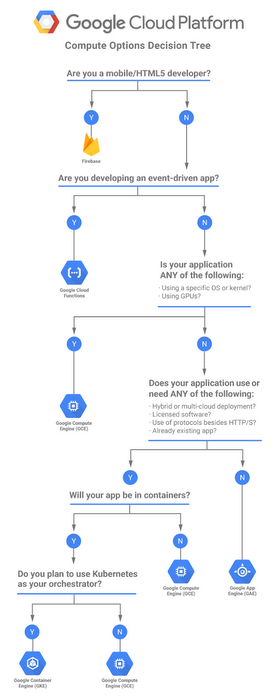Google Cloud Compute Options
Compute Engine
- provides Infrastructure as a Service (IaaS) in the Google Cloud
-
- provides full control/flexibility on the choice of OS, resources like CPU and memory
- Usage patterns
- lift and shift migrations of existing systems
- existing VM images to move to the cloud
- need low-level access to or fine-grained control of the operating system, network, and other operational characteristics.
- require custom kernel or arbitrary OS
- software that can’t be easily containerized
- using a third party licensed software
- Usage anti-patterns
- containerized applications – Choose App Engine, GKE, or Cloud Run
- stateless event-driven applications – Choose Cloud Functions
App Engine
-
- helps build highly scalable web and mobile backend applications on a fully managed serverless platform
-
- Usage patterns
- Rapidly developing CRUD-heavy applications
- HTTP/S based applications
- Deploying complex APIs
- Usage anti-patterns
- Stateful applications requiring lots of in-memory states to meet the performance or functional requirements
- Systems that require protocols other than HTTP
Google Kubernetes Engine – GKE
- provides a managed environment for deploying, managing, and scaling containerized applications using Google infrastructure.
- Usage patterns
- containerized applications or those that can be easily containerized
- Hybrid or multi-cloud environments
- Systems leveraging stateful and stateless services
- Strong CI/CD Pipelines
- Usage anti-patterns
- non-containerized applications – Choose CE or App engine
- applications requiring very low-level access to the underlying hardware like custom kernel, networking, etc. – Choose CE
- stateless event-driven applications – Choose Cloud Functions
Cloud Run
- provides a serverless managed compute platform to run stateless, isolated containers without orchestration that can be invoked via web requests or Pub/Sub events.
-
- abstracts away all infrastructure management allowing users to focus on building great applications.
- is built from Knative.
- Usage patterns
- Stateless services that are easily containerized
- Event-driven applications and systems
- Applications that require custom system and language dependencies
- Usage anti-patterns
- Highly stateful systems
- Systems that require protocols other than HTTP
- Compliance requirements that demand strict controls over the low-level environment and infrastructure (might be okay with the Knative GKE mode)
Cloud Functions
-
-
provides serverless compute for event-driven apps
- Usage patterns
- ephemeral and event-driven applications and functions
- fully managed environment
- pay only for what you use
- quick data transformations (ETL)
- Usage anti-patterns
- continuous stateful application – Choose CE, App Engine or GKE

Google Cloud Compute Options Decision Tree

GCP Certification Exam Practice Questions
- Questions are collected from Internet and the answers are marked as per my knowledge and understanding (which might differ with yours).
- GCP services are updated everyday and both the answers and questions might be outdated soon, so research accordingly.
- GCP exam questions are not updated to keep up the pace with GCP updates, so even if the underlying feature has changed the question might not be updated
- Open to further feedback, discussion and correction.
- Your organization is developing a new application. This application responds to events created by already running applications. The business goal for the new application is to scale to handle spikes in the flow of incoming events while minimizing administrative work for the team. Which Google Cloud product or feature should you choose?
- Cloud Run
- Cloud Run for Anthos
- App Engine standard environment
- Compute Engine
- A company wants to build an application that stores images in a Cloud Storage bucket and wants to generate thumbnails as well as resize the images. They want to use managed service which will help them scale automatically from zero to scale and back to zero. Which GCP service satisfies the requirement?
- Google Compute Engine
- Google Kubernetes Engine
- Google App Engine
- Cloud Functions